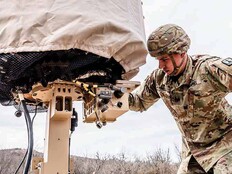The Intelligence Community just signed and will soon release a data reference architecture intended to help its 18 elements connect siloed data across their distributed ecosystem, according to Chief Data Officer Lori Wade.
A data and artificial intelligence (AI) summit slated for January will kick off the IC’s efforts to implement the reference architecture, which will involve stress testing it with mission sprints alongside partners such as the Five Eyes intelligence alliance, Wade said.
The reference architecture was a deliverable of the IC Data Strategy published in 2023, and its release signifies that the IC is making progress toward data interoperability.
“For the U.S. intelligence community, we need to be able to scale advanced analytics to process large and compounding volumes of data for the sole purpose of having timely, accurate, trusted data for decision-making and insights,” Wade said, speaking at the 2024 DoDIIS Worldwide Conference in Omaha, Neb. “We need to do that in this extremely interconnected digital and evolving environment.”
Click here to learn more about optimizing your cloud connection.
What’s in the IC’s Data Reference Architecture and Why
The IC’s data reference architecture consists of four principles: domain ownership, decentralized stewardship, self-service and federated computational governance.
To achieve self-service, the IC proposes a data platform that would enable all its elements to manage and clean their own data while ensuring it is interoperable across the ecosystem. This is currently a challenge because elements have their own cataloging and data services and repositories.
The reference architecture also covers the Department of Defense, the private sector, and Five Eyes and NATO allies, all of which had input into its development.
“Without it, I’m not sure we get to a place where we scale,” Wade said.
Scaling is important because the increasing volume of data being collected by the IC increases cyber risk and costs to its elements. AI requires computing and power, and IC elements are already running out of funds for those resources, Wade said.
At the same time, much of the IC elements’ tooling hasn’t been upgraded in 15 years, and their data tagging and labeling remain highly manual processes.
“We’ve got to get the mission side making better decisions upfront about the data as it goes through its lifecycle, because they just are assuming that the enterprise is paying to keep all that data,” Wade said.
Click the banner below to keep up with FedTech as an Insider.
AI Presents its Own Challenges for the IC
The IC needs to do more AI algorithmic work and write prompts. “The problem is all the conversations I’m in lead us to an AI gold rush,” Wade said.
AI-related investments could peak as high as 2.5% to 4% of the U.S. gross domestic product, a higher cost than the entire national defense budget, and the IC hasn’t even factored workforce training into the equation yet, Wade said.
The IC did stand up a data operations group earlier this year. “Data operations is where we’re going to look and see how we’re going to take on real mission challenges,” Wade said.
To learn more about DoDIIS Worldwide, visit our conference page. You can also follow us on the social platform X at @FedTechMagazine to see behind-the-scenes moments.















